海牙-维斯比规则(中英对照)
- 格式:doc
- 大小:103.00 KB
- 文档页数:44
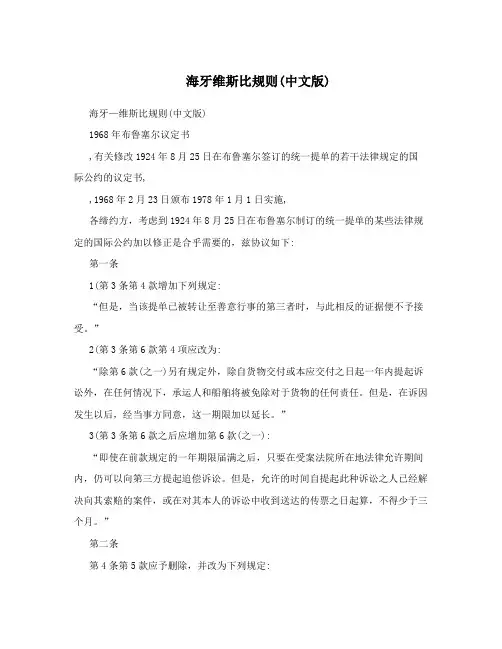
海牙维斯比规则(中文版)海牙—维斯比规则(中文版)1968年布鲁塞尔议定书,有关修改1924年8月25日在布鲁塞尔签订的统一提单的若干法律规定的国际公约的议定书,,1968年2月23日颁布1978年1月1日实施,各缔约方,考虑到1924年8月25日在布鲁塞尔制订的统一提单的某些法律规定的国际公约加以修正是合乎需要的,兹协议如下:第一条1(第3条第4款增加下列规定:“但是,当该提单已被转让至善意行事的第三者时,与此相反的证据便不予接受。
”2(第3条第6款第4项应改为:“除第6款(之一)另有规定外,除自货物交付或本应交付之日起一年内提起诉讼外,在任何情况下,承运人和船舶将被免除对于货物的任何责任。
但是,在诉因发生以后,经当事方同意,这一期限加以延长。
”3(第3条第6款之后应增加第6款(之一):“即使在前款规定的一年期限届满之后,只要在受案法院所在地法律允许期间内,仍可以向第三方提起追偿诉讼。
但是,允许的时间自提起此种诉讼之人已经解决向其索赔的案件,或在对其本人的诉讼中收到送达的传票之日起算,不得少于三个月。
”第二条第4条第5款应予删除,并改为下列规定:(a)不论是承运人或船舶,对超过每件或每单位相当于10000法郎,或按灭失或受损货物毛重计算,每公斤相当于30法郎(两者之中以较高者为准)的货物或与货物有关的灭失或损害,在任何情况下,概不负责,除非货物的性质和价值已由托运人在货物装运前声明,并在提单上注明。
1(b)可赔偿的总额应参照该货物根据合同从船上卸下或本应卸下的当时当地的价值计算。
货物价值应按商品交换价格确定,或者,如无此种价格,按现时市场价格计算;如无商品交换价格和现时市场价格,参照相同品种和质量的货物的正常价值确定。
(c)如货物是以集装箱、货盘或类似的运输工具集装,则提单中载明的装在此种运输工具中的件数或单位数,应视为本款所述件数或单位数。
除上述情况之外,此种运输工具应视为一个包件或单位。
(d)一个法郎是指一个含有纯度为千分之九百的黄金65.5毫克的单位。
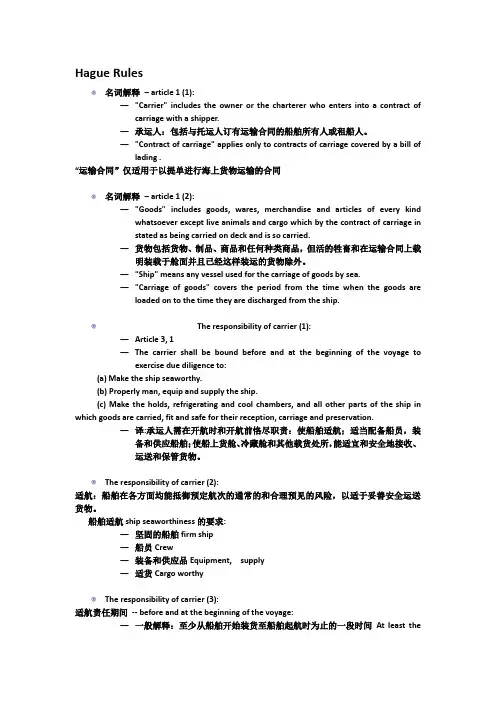
Hague Rules名词解释– article 1 (1):―"Carrier" includes the owner or the charterer who enters into a contract of carriage with a shipper.―承运人:包括与托运人订有运输合同的船舶所有人或租船人。
―"Contract of carriage" applies only to contracts of carriage covered by a bill of lading .“运输合同”仅适用于以提单进行海上货物运输的合同名词解释– article 1 (2):―"Goods" includes goods, wares, merchandise and articles of every kind whatsoever except live animals and cargo which by the contract of carriage instated as being carried on deck and is so carried.―货物包括货物、制品、商品和任何种类商品,但活的牲畜和在运输合同上载明装载于舱面并且已经这样装运的货物除外。
―"Ship" means any vessel used for the carriage of goods by sea.―"Carriage of goods" covers the period from the time when the goods are loaded on to the time they are discharged from the ship.The responsibility of carrier (1):―Article 3, 1―The carrier shall be bound before and at the beginning of the voyage to exercise due diligence to:(a) Make the ship seaworthy.(b) Properly man, equip and supply the ship.(c) Make the holds, refrigerating and cool chambers, and all other parts of the ship in which goods are carried, fit and safe for their reception, carriage and preservation.―译:承运人需在开航时和开航前恪尽职责:使船舶适航;适当配备船员,装备和供应船舶;使船上货舱、冷藏舱和其他载货处所,能适宜和安全地接收、运送和保管货物。
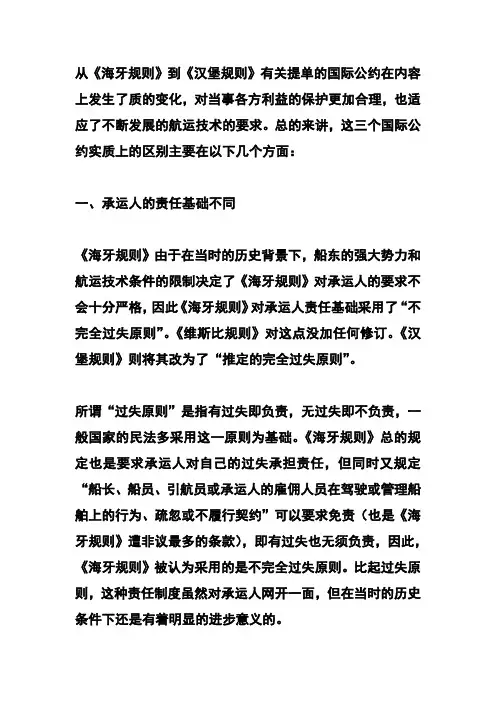
从《海牙规则》到《汉堡规则》有关提单的国际公约在内容上发生了质的变化,对当事各方利益的保护更加合理,也适应了不断发展的航运技术的要求。
总的来讲,这三个国际公约实质上的区别主要在以下几个方面:一、承运人的责任基础不同《海牙规则》由于在当时的历史背景下,船东的强大势力和航运技术条件的限制决定了《海牙规则》对承运人的要求不会十分严格,因此《海牙规则》对承运人责任基础采用了“不完全过失原则”。
《维斯比规则》对这点没加任何修订。
《汉堡规则》则将其改为了“推定的完全过失原则”。
所谓“过失原则”是指有过失即负责,无过失即不负责,一般国家的民法多采用这一原则为基础。
《海牙规则》总的规定也是要求承运人对自己的过失承担责任,但同时又规定“船长、船员、引航员或承运人的雇佣人员在驾驶或管理船舶上的行为、疏忽或不履行契约”可以要求免责(也是《海牙规则》遭非议最多的条款),即有过失也无须负责,因此,《海牙规则》被认为采用的是不完全过失原则。
比起过失原则,这种责任制度虽然对承运人网开一面,但在当时的历史条件下还是有着明显的进步意义的。
《汉堡规则》的立场则严格得多,它不仅以是否存在过失来决定承运人是否负责,而且规定举证责任也要由承运人承担,即第五条规定的“除非承运人证明他本人,其受雇人或代理人为避免该事故发生及其后果已采取了一切所能合理要求的措施,否则承运人应对货物灭失或损坏或延迟交货所造成的损失负赔偿责任……。
”这样承运人的责任大大加重了。
二、承运人的最高责任赔偿限额不同首先,从《海牙规则》到《汉堡规则》依次提高了对每单位货物的最高赔偿金额。
《海牙规则》规定船东或承运人对货物或与货物有关的灭失或损坏的赔偿金额不超过每件或每单位100英镑或相当于100英镑的等值货币。
《维斯比规则》将最高赔偿金额提高为每件或每单位10000金法郎或按灭失或受损货物毛重计算,每公斤30金法郎,两者以较高金额的为准。
同时明确一个金法郎是一个含有66.5毫克黄金,纯度为千分之九百的单位。
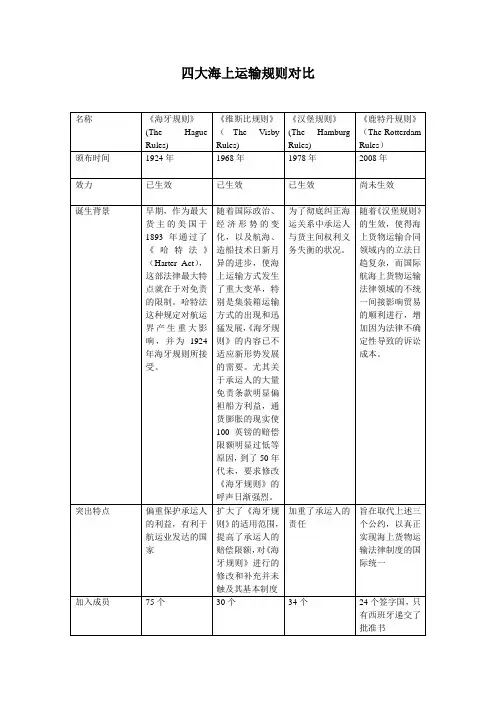

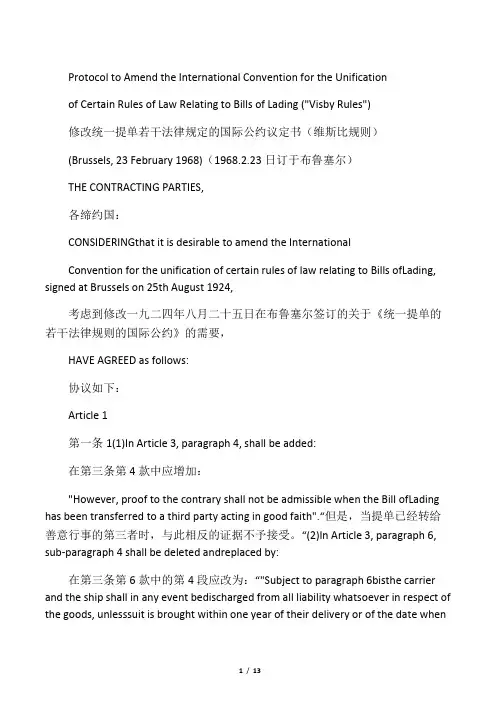
Protocol to Amend the International Convention for the Unificationof Certain Rules of Law Relating to Bills of Lading ("Visby Rules")修改统一提单若干法律规定的国际公约议定书(维斯比规则)(Brussels, 23 February 1968)(1968.2.23日订于布鲁塞尔)THE CONTRACTING PARTIES,各缔约国:CONSIDERINGthat it is desirable to amend the InternationalConvention for the unification of certain rules of law relating to Bills ofLading, signed at Brussels on 25th August 1924,考虑到修改一九二四年八月二十五日在布鲁塞尔签订的关于《统一提单的若干法律规则的国际公约》的需要,HAVE AGREED as follows:协议如下:Article 1第一条1(1)In Article 3, paragraph 4, shall be added:在第三条第4款中应增加:"However, proof to the contrary shall not be admissible when the Bill ofLading has been transferred to a third party actin g in good faith".“但是,当提单已经转给善意行事的第三者时,与此相反的证据不予接受。
“(2)In Article 3, paragraph 6, sub-paragraph 4 shall be deleted andreplaced by:在第三条第6款中的第4段应改为:“"Subject to paragraph 6bisthe carrier and the ship shall in any event bedischarged from all liability whatsoever in respect of the goods, unlesssuit is brought within one year of their delivery or of the date whentheyshould have been delivered. This period may, however, be extended ifthe parties so agree after the cause of action has arisen".“遵照第6款(修改本)的规定,除非从货物交付之日或应付之日起一年内提起诉讼,承运人和船舶在任何情况下都免除对于货物的货物责任。
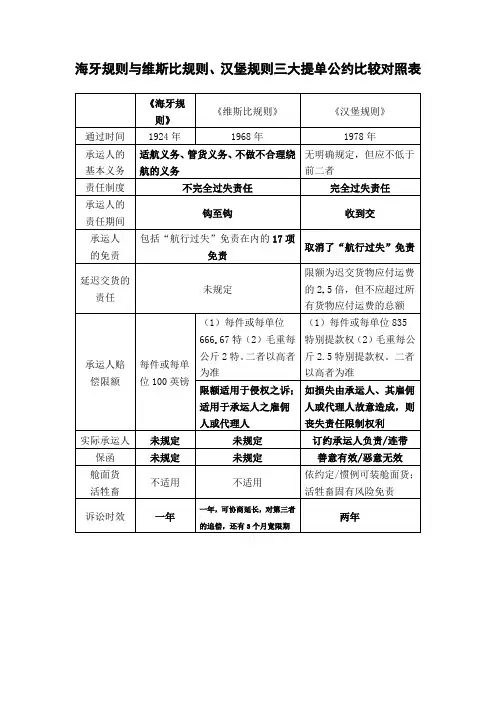
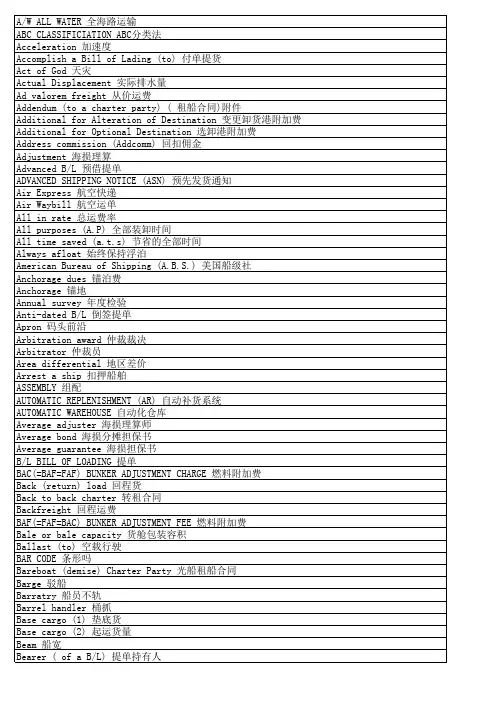

统一提单的若干法律规则的国际公约(1924年8月22日订于布鲁塞尔,1924年8月25日颁布,1942年8月25日实施)《海牙规则》第一条本公约所用下列各词,涵义如下:(a) “承运人”包括与托运人订有运输合同的船舶所有人或租船人。
(b) “运输合同”仅适用于以提单或任何类似的物权凭证进行有关海上货物运输的合同;在租船合同下或根据租船合同所签发的提单或任何物权凭证,在它们成为制约承运人与凭证持有人之间的关系准则时,也包括在内。
(c) “货物”包括货物、制品、商品和任何种类的物品,但活牲畜以及在运输合同上载明装载于舱面上并且已经这样装运的货物除外。
(d) “船舶”是指用于海上货物运输的任何船舶。
(e) “货物运输”是指自货物装上船时起,至卸下船时止的一段期间。
第二条除遵照第六条规定外,每个海上货物运输合同的承运人,对有关货物的装载、搬运、积载、运送、保管、照料和卸载,都应按照下列规定承担责任和义务,并享受权利和豁免。
第三条1.承运人须在开航前和开航时谨慎处理:(a) 使船舶适航;(b) 适当地配备船员、装备船舶和供应船舶;(c) 使货舱、冷藏舱和该船其他载货处所能适宜和安全地收受、运送和保管货物。
2.除遵照第四条规定外,承运人应适当和谨慎地装卸、搬运、积载、运送、保管、照料和卸载所运货物。
3.承运人或船长或承运人的代理人在收受货物归其照管后,经托运人的请求,应向托运人签发提单,其上载明下列各项:(a) 与开始装货前由托运人书面提供者相同的、为辨认货物所需的主要标志,如果这项标志是以印戳或其他方式标示在不带包装的货物上,或在其中装有货物的箱子或包装物上,该项标志通常应在航程终了时仍能保持清晰可认。
(b) 托运人用书面提供的包数或件数,或数量,或重量。
(c) 货物的表面状况。
但是,承运人、船长或承运人的代理人,不一定必须将任何货物的标志、号码、数量或重量表明或标示在提单上,如果他有合理根据怀疑提单不能正确代表实际收到的货物,或无适当方法进行核对的话。

1《海商法》提单的证据力:第七十五条承运人或者代其签发提单的人,知道或者有合理的根据怀疑提单记载的货物的品名、标志、包数或者件数、重量或者体积与实际接收的货物不符,在签发己装船提单的情况下怀疑与已装船的货物不符,或者没有适当的方法核对提单记载的,可以在提单上批注,说明不符之处、怀疑的根据或者说明无法核对。
第七十六条承运人或者代其签发提单的人未在提单上批注货物表面状况的,视为货物的表面状况良好。
第七十七条除依照本法第七十五条的规定作出保留外,承运人或者代其签发提单的人签发的提单,是承运人已经按照提单所载状况收到货物或者货物已经装船的初步证据;承运人向善意受让提单的包括收货人在内的第三人提出的与提单所载状况不同的证据,不予承认。
2《海商法》承运人赔偿责任基础:第五十九条经证明,货物的灭失、损坏或者迟延交付是由于承运人的故意或者明知可能造成损失而轻率地作为或者不作为造成的,承运人不得援用本法第五十六条或者第五十七条限制赔偿责任的规定。
经证明,货物的灭失、损坏或者迟延交付是由于承运人的受雇人、代理人的故意或者明知可能造成损失而轻率地作为或者不作为造成的,承运人的受雇人或者代理人不得援用本法第五十六条或者第五十七条限制赔偿责任的规定。
第六十条承运人将货物运输或者部分运输委托给实际承运人履行的,承运人仍然应当依照本章规定对全部运输负责。
对实际承运人承担的运输,承运人应当对实际承运人的行为或者实际承运人的受雇人、代理人在受雇或者受委托的范围内的行为负责。
虽有前款规定,在海上运输合同中明确约定合同所包括的特定的部分运输由承运人以外的指定的实际承运人履行的,合同可以同时约定,货物在指定的实际承运人掌管期间发生的灭失、损坏或者迟延交付,承运人不负赔偿责任。
3《海商法》诉讼时效:第二百五十七条就海上货物运输向承运人要求赔偿的请求权,时效期间为一年,自承运人交付或者应当交付货物之日起计算;在时效期间内或者时效期间届满后,被认定为负有责任的人向第三人提起追偿请求的,时效期间为90日,自追偿请求人解决原赔偿请求之日起或者收到受理对其本人提起诉讼的法院的起诉状副本之日起计算。

海牙规则、维斯比规则、汉堡规则这三个公约都是调整班轮运输(海运)的国际公约。
他们的主要内容就是规定在国际班轮运输中,承运人承担的责任有哪些,以及承担责任的期间和免责事项、责任限额;托运人的责任、义务以及托运人索赔的期限等等。
一、海牙规则(Hague Rules)海牙规则的全称是《统一提单若干法律规定的国际公约》(International Convention for the Unification /ju:nɪfɪkeɪʃɵn/ n. 统一,联合,一致of Certain Rules of Law Relating to Bill of Lading),1924年8月25日由26个国家在布鲁塞尔签订,1931年6月2日生效。
公约草案是1921年在海牙通过,因此定名为海牙规则。
包括欧美许多国家在内的50多个国家都先后加入了这个公约。
1936年,美国政府以这一公约作为国内立法的基础制定了1936年美国海上货物运输法。
海牙规则使得海上货物运输中有关提单的法律得以统一,在促进海运事业发展,推动国际贸易发展方面发挥了积极作用,是最重要的和目前仍被普遍使用的国际公约,我国于1981年承认该公约。
海牙规则的特点是:①较多的维护了承运人的利益②在风险分担上很不均衡③未考虑集装箱运输形式的需要制定海牙规则时,集装箱运输方式尚未出现。
④赔偿责任限额过低⑤诉讼时效太短一年《海牙规则》共十六条,其中第一至第十条是实质性条款,第十一至第十六条是程序性条款,主要是有关公约的批准、加入和修改程序性条款。
实质性条款主要包括以下内容:1、承运人最低限度的义务。
所谓承运人最低限度义务,就是承运人必须履行的基本义务。
对此《海牙规则》第三条第一款规定:“承运人必须在开航前和开航当时,谨慎处理,使航船处于适航状态,妥善配备合格船员,装备船舶和配备供应品;使货舱、冷藏舱和该船其他载货处所能适当而安全地接受、载运和保管货物。
”该条第二款规定:“承运人应妥善地和谨慎地装载、操作、积载、运送、保管、照料与卸载。
比较《海牙规则》、《维斯比规则》、《汉堡规则》和《鹿特丹规则》表格形式四大海上运输规则对比Act),这部法律最大特点就在于对免责的限制。
哈特法这种规定对航运界产生重大影响,并为1924年海牙规现和迅猛发展,《海牙规则》的内容已不适应新形势发展的需要。
尤其关于承运人的大量免责条款明显偏袒船方利益,通货膨胀的现实使100英镑的赔偿限额明显过低等原因,到了50年代未,要求修改《海牙规则》货物运输法律领域的不统一间接影响贸易的顺利进行,增加因为法律不确定性导致的诉讼成本。
利于航运业发达的国家限额,对《海牙规则》进行的修改和补充并未触及其基本制度海上货物运输法律制度的国际统一加入成员75个30个34个24个签字国,只有西班牙递交了批准书适用范围仅适用于在缔约国签发的提单。
在缔约国签发的提单;货物在一个缔约国的港口起运;提单载明或为提单所证明的根据《汉堡规则》的规定,凡《海牙规则》和/或《维适用于任何方式的运输合同,只要其中有部分运输是束,不论承运人、托运人或者任何其他有关人员的国籍如何。
即只要当事人自愿选择适用,则该提单或运输合同就要受《维斯比规则》的约束声明退出以上两个条约。
地理上的联系,即只要运输合同约定的收货地、装货港、交货地或卸货港之一位于一个缔约国之内,公约就适用。
货物的不包括舱面货物和集承运人只有与托运人或条例要求时,才能在舱面载运货物,否则要对舱面货物发生的损失负赔偿责任。
对于活动物,只要承运人证明是按托灭失、损坏或延迟交货造成的损失视为运输固有的特殊风险而不承担责任。
承运人的义两项最低限度的义务---“管船”“管进一步规定,如果损失是由于承运人蓄意造成的,或者知道很可能会将承运人的适航义务扩展至整个航次期间,使利甚至承运人几乎没有免责的机会。
承运人的责任期间“钩至钩”“舷至舷”原则,合同之诉和侵权之诉处于相同的地位延长了承运人的责任限制,从托运人把货物交给承运人掌管之日起至承运人把货物交在一定程度上增加了承运人的责任,该规则适用于承运热在船边交接货物、港口交接货物、港外交接货物承运人的免责事项1.过失免责事项2.无过失免责条款保留了航海过失免责,规定承运人的受雇人和代理人也可以援引航海过失免责,同时也将航海过失免责可对抗的请求理由扩大到侵权。
1《海商法》提单的证据力:第七十五条承运人或者代其签发提单的人,知道或者有合理的根据怀疑提单记载的货物的品名、标志、包数或者件数、重量或者体积与实际接收的货物不符,在签发己装船提单的情况下怀疑与已装船的货物不符,或者没有适当的方法核对提单记载的,可以在提单上批注,说明不符之处、怀疑的根据或者说明无法核对。
第七十六条承运人或者代其签发提单的人未在提单上批注货物表面状况的,视为货物的表面状况良好。
第七十七条除依照本法第七十五条的规定作出保留外,承运人或者代其签发提单的人签发的提单,是承运人已经按照提单所载状况收到货物或者货物已经装船的初步证据;承运人向善意受让提单的包括收货人在内的第三人提出的与提单所载状况不同的证据,不予承认。
2《海商法》承运人赔偿责任基础:第五十九条经证明,货物的灭失、损坏或者迟延交付是由于承运人的故意或者明知可能造成损失而轻率地作为或者不作为造成的,承运人不得援用本法第五十六条或者第五十七条限制赔偿责任的规定。
经证明,货物的灭失、损坏或者迟延交付是由于承运人的受雇人、代理人的故意或者明知可能造成损失而轻率地作为或者不作为造成的,承运人的受雇人或者代理人不得援用本法第五十六条或者第五十七条限制赔偿责任的规定。
第六十条承运人将货物运输或者部分运输委托给实际承运人履行的,承运人仍然应当依照本章规定对全部运输负责。
对实际承运人承担的运输,承运人应当对实际承运人的行为或者实际承运人的受雇人、代理人在受雇或者受委托的范围内的行为负责。
虽有前款规定,在海上运输合同中明确约定合同所包括的特定的部分运输由承运人以外的指定的实际承运人履行的,合同可以同时约定,货物在指定的实际承运人掌管期间发生的灭失、损坏或者迟延交付,承运人不负赔偿责任。
3《海商法》诉讼时效:第二百五十七条就海上货物运输向承运人要求赔偿的请求权,时效期间为一年,自承运人交付或者应当交付货物之日起计算;在时效期间内或者时效期间届满后,被认定为负有责任的人向第三人提起追偿请求的,时效期间为90日,自追偿请求人解决原赔偿请求之日起或者收到受理对其本人提起诉讼的法院的起诉状副本之日起计算。
统一提单的若干法律规则的国际公约(1924年8月22日订于布鲁塞尔,1924年8月25日颁布,1942年8月25日实施)INTERNATIONAL CONVENTION FOR THE UNIFICATION OF CERTAIN RULES OFLAW RELATING TO BILLS OF LADING(“HAGUE RULES”), AND PROTOCOL OF SIGNATURE(Brussels, 25 August 1924)The President of the German Republic, the President of the Argentine Republic, His Majesty the King of the Belgians, the President of the Republic of Chile, the President of the Republic of Cuba, His Majesty the King of Denmark and Iceland, His Majesty the King of Spain, the Head of the Estonian State, the President of the United States of America, the President of the Republic of Finland, the President of the French Republic, His Majesty the King of the United Kingdom of Great Britain and Ireland and of the British Dominions beyond the Seas, Emperor of India, His Most Supreme Highness the Governor of the Kingdom of Hungary, His Majesty the King of Italy, His Majesty the Emperor of Japan, the President of the Latvian Republic, the President of the Republic of Mexico, His Majesty the King of Norway, Her Majesty the Queen of the Netherlands, the President of the Republic of Peru, the President of the Polish Republic, the President of the Portuguese Republic, His Majesty the King ofRomania, His Majesty the King of the Serbs, Croats and Slovenes, His Majesty the King of Sweden, and the President of the Republic of Uruguay,HAVING RECOGNIZED the utility of fixing by agreement certain uniform rules of law relating to bills of lading,HAVE DECIDED to conclude a convention with this object and have appointed the following Plenipotentiaries:WHO, duly authorized thereto, have agreed as follows:第一条Article 1本公约所用下列各词,涵义如下:In this Convention the following words are employed with the meanings set out below:(a) “承运人”包括与托运人订有运输合同的船舶所有人或租船人。
(a)"Carrier" includes the owner or the charterer who enters into a contract of carriage with a shipper.(b)“运输合同”仅适用于以提单或任何类似的物权凭证进行有关海上货物运输的合同;在租船合同下或根据租船合同所签发的提单或任何物权凭证,在它们成为制约承运人与凭证持有人之间的关系准则时,也包括在内。
(b)"Contract of carriage" applies only to contracts of carriage covered by a bill of lading or any similar document of title, in so far as such document relates to the carriage of goods by sea, including any bill of lading or any similar document as aforesaid issued under or pursuant to a charter party from the moment at which such bill of lading or similar document of title regulates the relations between a carrier and a holder of the same.(c)“货物”包括货物、制品、商品和任何种类的物品,但活牲畜以及在运输合同上载明装载于舱面上并且已经这样装运的货物除外。
(c)"Goods" includes goods, wares, merchandise and articles of every kind whatsoever except live animals and cargo which by the contract of carriage in stated as being carried on deck and is so carried.(d) “船舶”是指用于海上货物运输的任何船舶。
(d)"Ship" means any vessel used for the carriage of goods by sea.“货物运输”是指自货物装上船时起,至卸下船时止的一段期间。
(e)"Carriage of goods" covers the period from the time when the goods are loaded on to the time they are discharged from the ship.第二条Article 2除遵照第六条规定外,每个海上货物运输合同的承运人,对有关货物的装载、搬运、积载、运送、保管、照料和卸载,都应按照下列规定承担责任和义务,并享受权利和豁免。
Subject to the provisions of Article 6, under every contract of carriage of goods by sea the carrier, in relation to the loading, handling, stowage, carriage, custody, care and discharge of such goods, shall be subject to the responsibilities and liabilities, and entitled to the rights and immunities hereinafter set forth.第三条Article 31.承运人须在开航前和开航时谨慎处理:1.The carrier shall be bound before and at the beginning of the voyage to exercise due diligence to:(a)使船舶适航;(a)Make the ship seaworthy.(b) 适当地配备船员、装备船舶和供应船舶;(b)Properly man, equip and supply the ship.(c) 使货舱、冷藏舱和该船其他载货处所能适宜和安全地收受、运送和保管货物。
(c)Make the holds, refrigerating and cool chambers, and all other parts of the ship in which goods are carried, fit and safe for their reception, carriage and preservation.2.除遵照第四条规定外,承运人应适当和谨慎地装卸、搬运、积载、运送、保管、照料和卸载所运货物。
2.Subject to the provisions of Article 4, the carrier shall properly and carefully load, handle, stow, carry, keep, care for, and discharge the goods carried.3.承运人或船长或承运人的代理人在收受货物归其照管后,经托运人的请求,应向托运人签发提单,其上载明下列各项:3.After receiving the goods into his charge the carrier or the master or agent of the carrier shall, on demand of the shipper, issue to the shipper a bill of lading showing among other things:(a) 与开始装货前由托运人书面提供者相同的、为辨认货物所需的主要标志,如果这项标志是以印戳或其他方式标示在不带包装的货物上,或在其中装有货物的箱子或包装物上,该项标志通常应在航程终了时仍能保持清晰可认。
(a)The leading marks necessary for identification of the goods as the same are furnished in writing by the shipper before the loading of such goods starts, provided such marks are stamped or otherwise shown clearly upon the goods ifuncovered, or on the cases or coverings in which such goods are contained, in such a manner as should ordinarily remain legible until the end of the voyage. (b) 托运人用书面提供的包数或件数,或数量,或重量。